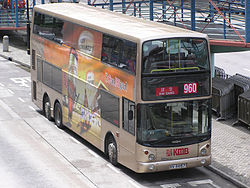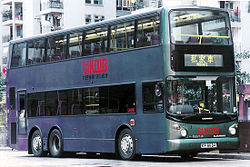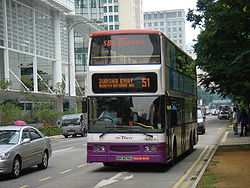- Dennis Trident 3
-
Dennis Trident 3 
KMB's 12m Trident 3 (ATR7) with Alexander ALX500 body.Manufacturer Dennis
/TransBus International (badged as Dennis)Built at Guildford, England Replaced Dennis Dragon Operator(s) Kowloon Motor Bus
New World First Bus and othersSpecifications Length 10.3m, 10.6m, 11.3m or 12m Width 2.5m Floor type Low floor Doors 1 or 2 door Engine(s) Cummins M11/ISM/ISMe Power output 305hp/330hp/335hp Transmission Voith/ZF Options Various customer options - For 2-axle, transverse-engined Dennis Trident which is mainly built for the UK market, see Dennis Trident 2.
Dennis Trident 3[1] (marketed as 3-axle Dennis Trident) is the first low floor double-decker bus chassis built by Dennis in the United Kingdom, with a large number purchased by bus companies in Hong Kong, Singapore, the United States and Canada.
Contents
Design
The Trident 3 chassis was developed from Dennis Lance/Arrow. It had a longitudinally-mounted rear engine, with a radiator mounted on the right hand side of the engine. An auxiliary axle was mounted behind the second axle to cope with the weight at the rear and reduce the rear overhang.
Trident 3 was available in 4 different body lengths: 10.3m, 10.6m, 11.3m and 12m. It could be fitted with Alexander ALX500 or Duple Metsec DM5000 bodywork.
Engine
The engines used for these buses were all manufactured by Cummins. Earlier models use the M11-305E, a 305hp engine which complies with Euro II standards, or an ISM-330 330hp engine for the buses delivered to North America.
The M11-305E engine was replaced by the Cummins ISMe Euro III-standard engine in 2001. A 330hp version (the ISMe330) was used initially, but later models in Hong Kong adopted a 335hp (ISMe335) version.
Gearbox
Initially the options of gearbox included Voith DIWA863.3 and ZF 5HP590. Later Voith DIWA864.4 and DIWA864.3 gearbox were also chosen, but both were replaced by Voith DIWA864.3E gearbox.
For Euro III-engined Tridents, almost all of them were fitted with Voith DIWA864.3E gearbox, only 10 were fitted with ZF 5HP602 gearbox.
The prototypes
Six prototypical Dennis Trident 3 chassis were built in 1996.
The first Trident 3 chassis was delivered to Alexander in late 1996 and received a body with the front resembled to R-type design. It was retained by Dennis as a development vehicle. In 2005, it was converted to open top and sold for promotion of British newspaper The Sun.
The other 5 were all delivered to Hong Kong, two went to Kowloon Motor Bus and three to Citybus.
Hong Kong
Kowloon Motor Bus and Long Win Bus
Prototypes
The assembly of the first Trident for Hong Kong was finished in February 1997. It has an Alexander ALX500 bodywork and had Kowloon Motor Bus (KMB) air-conditioned bus livery. However, Dennis reserved this bus for tests initially.
The second prototype was finished and delivered to Hong Kong in May 1997, also having an ALX500 body and the KMB air-conditioned bus livery. When it arrived at Hong Kong, it was repainted with a golden colour. A red line indicating the floor of bus compartment was added, with people-like figures (designed with computers) situated just above the red line. This decoration work was for the purpose of showing that this bus is a "Super-low-floor" bus, which has better accessibility for passengers. The bus was assigned for several open activities for promotion before getting licensed in September 1997. It entered service two months later and had been in service on route 1A before being reallocated in 2005.
KMB adopted the class code ATR for Trident 3, which would also be used to number the production models.
The first prototype was delivered to Hong Kong later and entered service in 1999, with fleet number ATR101, meaning it is the 101st Trident 3 registered under KMB.
First batch (1997 to 1999)
For the first batch, KMB purchased 186 Tridents for its local services, and another 150 for the new Hong Kong International Airport services under the name of Long Win Bus.
All 336 buses of this batch are 12 metres in length. The KMB batch is assorted with Alexander and Duple Metsec bodies, while the entire Long Win batch is Alexander-bodied. Furthermore, 25 of the Long Win Tridents were built with coach standard, and are used for express services into the airport.
The Long Win batch entered service first between 1997 and 1998, followed by the KMB batch from September 1998 to 1999.
KMB adopted the code ATR for its own Tridents, and assigned the code LW for the Long Win batch with ordinary standard (The numbering of LW class starts from 11, continuing from the 10 Volvo Olympians acquired by Long Win earlier in 1997). The coaches were assigned with the fleet code LWA.
Later, Long Win has its fleet number system revised, with the ordinary Tridents getting 1xx or 2xx fleet numbers, while the "coaches" got 5xx fleet numbers.
Further purchase (1999 to 2001)
The next batch of Tridents for KMB consists of 160 Duple Metsec-bodied productions.
The first 50 of them have a length of 10.6 metres (the code ATS was being assigned for them), and entered service between late 1999 and 2000. These buses are the last batch of KMB buses fitted with plastic route number and destination displays.
The next 110 of them are again 12 metres in length, and fitted with electronic route displays (This became the standard of all future buses bought by KMB).
Another 50 Alexander-bodied 10.6m Tridents entered KMB fleet in 2001. These Tridents' Alexander bodies were of a modified model, and all of them have electronic route displays. Two of them were experimentally fitted with Cummins ISMe Euro III standard engines and have special livery.
Last batch (2002 to 2003)
The last batch for KMB consists of 150 Alexander-bodied Tridents. These buses are fitted with electronic displays and Cummins ISMe Euro III standard engines, and have their bodies similar to the last 10.6-metre batch.
50 of the Tridents are 10.6 metres long, while the other 100 are 12 metres long. However, the order of 12 metres long Tridents was revised later and only 80 of them were ordered finally. The remaining 20 became the later TransBus Enviro500.
Transfers
It was soon found that Long Win did not get expected ridership and was in an excess of buses, so from 1999, 20 Tridents of Long Win were leased to KMB. 14 of them were officially acquired by KMB in December 2002, and the rest were returned to Long Win by 2005.
In 2010, Long Win had 20 Tridents transferred to KMB, the role of these buses in Long Win were taken over by 20 new Enviro500 buses.
Early withdrawal
Both KMB and Long Win have some of their Tridents withdrawn prematurely due to fire. Long Win lost one (fleet number 197) in July 1999 and got a replacement a year later. This replacement was Duple Metsec-bodied and with electronic displays, and received the fleet number 301.
One KMB Alexander-bodied Trident [Fleet number ATR6 (HV6943)] was destroyed by fire accidentally on 27 November 2002. The accident was caused by the leakage of flammable liquid brought by a passenger into the engine compartment. The bus was officially written off in the following year.
In July 2008, two Duple Metsec-bodied KMB's 12-metre Tridents [Fleet number ATR54 (HX7649) and ATR195 (JM8323)], one of KMB's Alexander-bodied 12-metre Trident (ex-Long Win vehicle) [Fleet number ATR358 (HR8939)] and one Duple Metsec-bodied 10.6-metre Trident [Fleet number ATS36 (JK6249)] were written off after being burnt out in KMB's depot in Tin Shui Wai on 31 March 2008.
Citybus
 Citybus's 12m Trident 3 (2144) for Cityflyer routes.
Citybus's 12m Trident 3 (2144) for Cityflyer routes.
Citybus's Trident fleet was not the largest, but often considered with greatest variety.
Prototypes
After KMB's first Trident was introduced, Citybus also had its prototype Tridents. The first prototype for Citybus was fleet-numbered as 2100. Having a Duple Metsec DM5000 body with coach specifications, it was introduced in November 1997.
The second and third prototypes were with ordinary bus specifications, and got their licenses one month after the first. The second prototype was fitted with Alexander ALX500 bodywork while the third was fitted with a Duple Metsec body. They got fleet numbers 2200 and 2201 respectively, in order to distinguish from the "coach" standard model.
Production batch
The production batches of Citybus Tridents entered service between 1997 and 1999.
For the coach standard branch, 11 Alexander-bodied Tridents entered service in late 1997, followed by 50 Duple Metsec-bodied examples. Numbered after the first prototype, their fleet numbers were 21-prefixed. All these buses were used for "Cityflyer" express services into Airport, although the Alexander-bodied frames are often substituted for semi-coaches described below. Fleet numbers 2101 and 2102 were later repainted in a special livery and reserved for route E22A.
The first batch of 22-prefixed production Tridents are often considered as "semi-coaches", as they have higher seat standards. A total of 60 semi-coaches entered service in 1998 to 1999 (although one of them stayed in Britain until its final delivery in 2000), while the following 40 (The last two were essentially 23-prefixed) were considered as ordinary standard buses.
Citybus also purchased the first 10.6m Trident 3 built by Dennis, which has Duple Metsec semi-coach body. It was introduced in 1999 with fleet number 2700.
Later purchases
In 2003, Citybus acquired 9 buses from NWFB and numbered them as 2302 to 2310, following its own production batch. They were fitted with luggage racks in the lower deck in 2007 to facilitate the introduction of new cross-border routes B3 and B3X from Tuen Mun via the Hong Kong-Shenzhen Western Corridor.
Early withdrawal
One Citybus Alexander-bodied 12-metre Trident [Fleet number 2111 (HP2678)] was destroyed by fire after colliding with a motorcycle at Lung Cheung Road near Diamond Hill Railway station on 14 April 2010. The bus was officially written off in the following year.
One Citybus Duple Metsec-bodied 12-metre Trident [Fleet number 2259 (HX5754)] was written off on 28 September 2011 after a traffic accident with a lorry near a roundabout at Chek Lap Kok South Road on Lautau Island on 21 May 2011.
New World First Bus
It was rumoured that China Motor Bus (CMB) had thought about purchasing ten Tridents in late 1996, but due to unpredictable delivery time Condors were bought instead. When New World First Bus won China Motor Bus's franchise in early 1998, plan was put forward of buying Tridents. Tridents have now accounted for over 50% of buses in its fleet.
First batch (1998 - 1999)
Three batches of NWFB Tridents are 12 metre in length, including the first batch of 160 Alexander-bodied Tridents and 42 Duple Metsec-bodied Tridents, both entering service starting from late 1998. NWFB assigned two different number schemes for these Tridents according to their bodywork (1001 onwards for Alexander bodied ones, and 3001 onwards for Duple bodied ones).
Second batch: Shorter variations (1999 - 2000)
The second NWFB batch entered service throughout 1999 as well as early 2000.
NWFB adopted a policy of purchasing shorter variations of Tridents in its second batch. 50 buses of this batch were still 12 metres in length (30 with Alexander ALX500 bodywork, and 20 with Duple Metsec bodies), but all others have a shorter length.
Thirty 11.3-metre Tridents entered service in 1999, along with sixty-two 10.6-metre ones. All these 92 buses were with Alexander ALX500 bodywork, and quickly replaced the old buses inherited from CMB.
A slightly later batch of 40 Tridents were fitted with specially-designed Duple Metsec bodywork. They were 10.3m (34ft) in length and 4.17m (13.7ft) in height, about a feet lower than standard models. These buses were designed for both height and length restrictive road conditions in the hills of Hong Kong Island, including the ones leading to The Peak. These buses' fleet numbers originally included an "L" (for Low height) at the end, but removed some years later.
Last batch (2000 - 2002)
A 10.6m Trident prototype was acquired by NWFB in 2000, but the next Trident batch came only two years later. 41 Tridents with Euro III standard engines entered NWFB in 2002. 21 of them were of Alexander-bodied 12m version, while the other 20 were 10.3m special editions. Essentially, the last special edition buses are also the last of Duple Metsec-bodied Tridents.
Redundancy
NWFB's expansion in its early years proved to be too fast, and redundancy grew up fairly quickly. Many of its buses were sold elsewhere in order to archieve better utilisation. Nine 12-metre Tridents in the last batch (fleet number 1201-1209) were transferred to Citybus in 2003, only one year after their entry of service.
53 Tridents were transferred to the bus division of KCRC starting in 2004. All of them were shorter Alexander-bodied versions, with forty-seven 10.6m ones and six 11.3m ones.
KCRC
KCRC introduced twenty-two 11.3m Tridents (601-622) in 2000, as an expansion of the company's bus services. They were the first Tridents to be fitted with modified Alexander ALX500 bodywork.
Between 2004 and 2005, KCRC acquired forty-seven 10.6m Tridents from NWFB and numbered them 701-747. In August 2005, the company also acquired six 11.3m Tridents from NWFB and numbered them 748-753. This was the largest bus acquisition of KCRC since its first purchase of buses back in 1987, and was partly because of the retirement of that particular batch of buses.
Other overseas orders
Canada
BC Transit of British Columbia, Canada ordered 11 Dennis Tridents with Duple Metsec bodywork in 1999. As 1 of them was damaged in transit, only 10 were allocated to Victoria and entered service in 2000.
In 2002, BC Transit introduced 19 Dennis Tridents with Duple Metsec bodywork (assembled by Alexander), with 1 of them as the replacement of the Trident damaged in transit. The first 16 were allocated to Victoria, the last 3 were allocated to Kelowna.
Singapore
Singapore Bus Services (now SBS Transit) of Singapore ordered 20 Tridents with Duple Metsec bodywork early in 1998. But due to large demand of Tridents from Hong Kong, the chassis were not built until late 1999.
They were finally delivered to Singapore in 1999 and underwent body assembly between 1999 and 2000. They were registered in the ranges of SBS 9671E to SBS 9690A and entered service in 2001. Until the arrival of the Scania K230UBs the Tridents were the only buses in the entire fleet of SBS Transit to feature electronic destination signs; other than for a few bus prototypes (including a Volvo Super Olympian currently in service on service 31), the company at the Tridents' time of introduction traditionally preferred plastic signs as a cost-saving measure.
They can now be found commonly in the northeastern and eastern parts of Singapore such as Hougang, Punggol, Sengkang, and Pasir Ris.
United States
Gray Line of the United States introduced 30 Tridents with open-top Duple Metsec bodywork (assembled by Alexander) for its sightseeing services, these were followed by 10 buses with the same specifications[citation needed].
They entered service in 2001 and were allocated to cities such as New York City and San Diego. It was known that the Tridents in San Diego were later transferred to New York City[citation needed].
Further development
In 2002, the Trident 3 chassis was modified and then introduced as a complete bus, which was known as TransBus Enviro500.
No more Trident 3 chassis was known to be built after 2002.
Notes
- ^ The vehicle type shown on the manufacturer's plate is either "TRIDENT" or "TRIDENT 3".
References
- Chan, Danny (1999). Dennis Buses in Hong Kong. Hong Kong: Northcord International. pp. 128–141. ISBN 9629200244.
See also
Competitors:
- MAN 24.310
- Neoplan Centroliner
- Scania K94UB
- Volvo B10TL
Buses Ace · Arrow (front-engined) · Dart (front-engined) · Dart (1970s front-engined) · Dart/Dart SLF · Dominant · Dominator · Domino · Dorchester · Dragon/Condor · E/EV · F/FS · Falcon (front-engined) · Falcon (rear-engined) · G/GL · H/HS/HV · Javelin · Jubilant · Lance/Lance 2/Lance 3 (front-engined) · Lance/Arrow/Lance SLF (rear-engined) · Lancet/Lancet 2/Lancet 3/Lancet 4 (front-engined) · Lancet UF · Lancet (underfloor-engined) · Loline · Mace · Pelican · Pike · R-Series · Trident 2 · Trident 3Fire engines Trucks Ace · Centaur · Condor · Delta · Hefty · Heron · Horia · Jubilant · Loyd Carrier · Max · Max Major · Maxim · Paravan · Pax · StorkCategory Chassis Bodies Enviro range Categories:- Buses
- Dennis vehicles
- Alexander Dennis
- Double-decker buses
- Road vehicles manufactured in the United Kingdom
Wikimedia Foundation. 2010.





